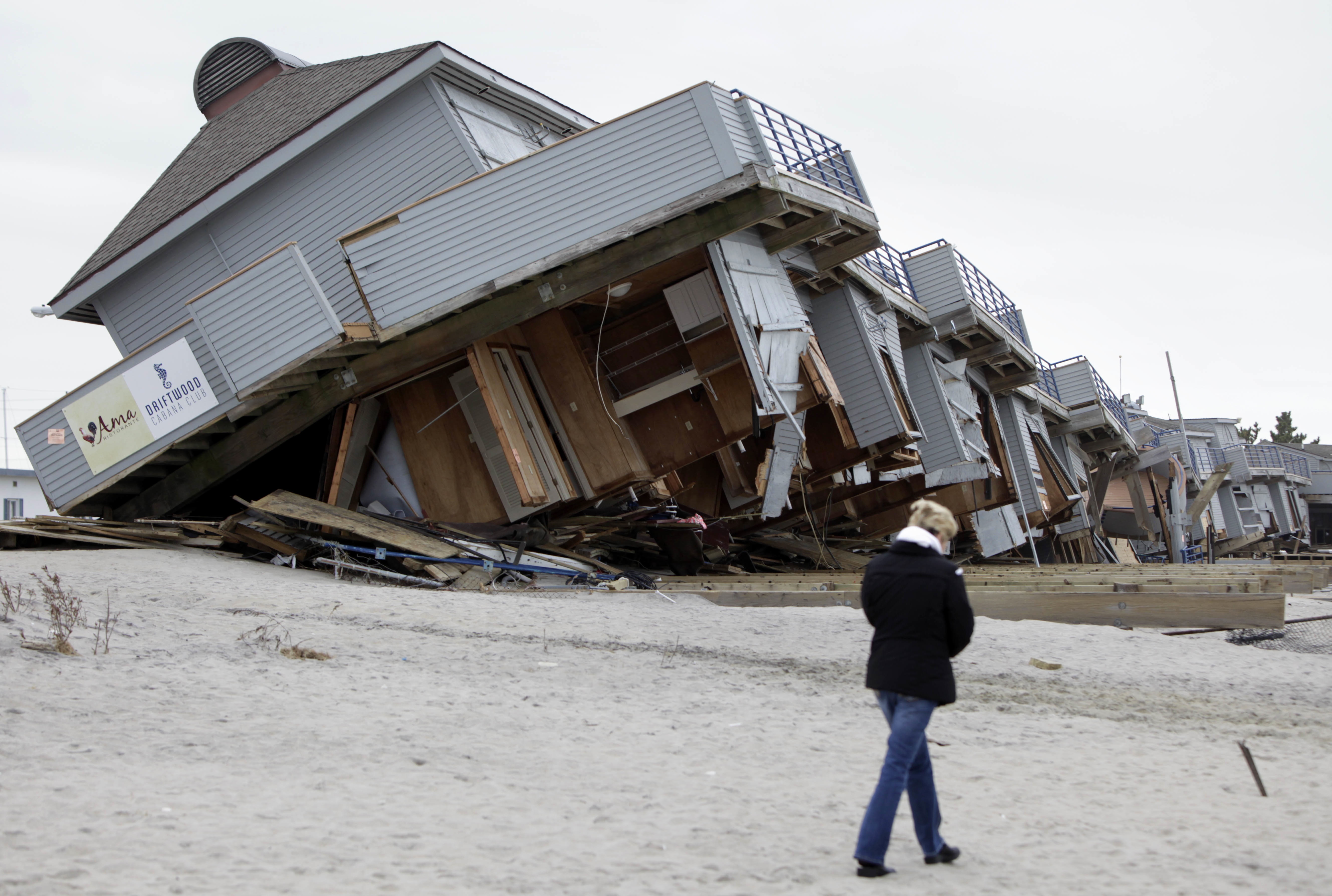Superstorm Sandy, one of the nation’s costliest natural disasters, is giving new urgency to an age-old debate about whether areas repeatedly damaged by storms should be rebuilt, or whether it might be cheaper in the long run to buy out vulnerable properties and let nature reclaim them.
The difficulty in getting aid for storm victims through Congress — most of a $60 billion package could get final approval next week — highlights the hard choices that may have to be made soon across the country, where the federal, state and local governments all say they don’t have unlimited resources to keep writing checks when storms strike.
But the idea of abandoning a place that has been home for years is unthinkable for many.

“We’re not retreating,” said Dina Long, the mayor of Sea Bright, N.J., a chronically flooded spit of sand between the Atlantic Ocean and the Shrewsbury River only slightly wider than the length of a football field in some spots.
Three-quarters of its 1,400 residents are still homeless and the entire business district was wiped out; only four shops have managed to reopen.
Despite a rock and concrete sea wall and pumping equipment in the center of town, Sea Bright floods repeatedly.
It is the go-to spot for TV news trucks every time a storm roars up the coast. But as in many other storm-damaged communities, there is a fierce will to survive, to rebuild and to restore.
“Nobody has come to us and said we shouldn’t exist,” she said. “It is antithetical to the Jersey mindset, and particularly to the Sea Bright mindset. We’re known for being strong, for being resilient, for not backing down.”
The story is different in the Oakwood Beach section of Staten Island, N.Y., where despite 20 years of flood protection measures, Sandy’s 12- to 14-foot-storm surge inundated the community, forcing some residents to their attics or roofs to survive. Three people died.
“Building again and again in this very sensitive flood plain will only achieve the same results _ flooding, and possibly untimely death,” homeowner Tina Downer told about 200 of her neighbors who gathered to discuss a potential buyout program last week. “It is not safe for anyone to live there.”
The problem has worsened in recent decades with an explosion of development near the nation’s shorelines. The National Oceanic and Atmospheric Administration said that in 2003, approximately 153 million people — 53 percent of the nation’s population — lived in coastal counties, an increase of 33 million people since 1980. The agency forecasts 12 million more to join them by 2015.
Scientists say that putting so many people in the most vulnerable areas is a recipe for disaster.
Jon Miller, a professor of coastal engineering at New Jersey’s Stevens Institute of technology, said retreating from the most vulnerable areas makes scientific sense. But he adds that the things that were built there — beach clubs, boardwalks and amusement piers — give communities their character, and fuel tourism and business.
If buyouts did occur, he predicted they would happen in areas with lower property values because of the high cost of buying up prime coastal real estate. That could have the unintended consequence of placing the shore off-limits to all but the wealthy, he said.
“I grew up in Rahway and I remember the controversy when several properties along the Rahway River were bought out due to repetitive flood losses,” Miller said. “It was painful and caused dissension in the community.”
Residents feared not only being forced from their homes but also not getting enough money to purchase a suitable home in the same community, Miller said.
A 1988 Duke University shore protection study cited a nor’easter that occurred in Sea Bright four years earlier, causing $82 million in damages — about equal to the value of all the town’s buildings at the time.
“Clearly the economics of this situation dictate that Sea Bright is not worthy of salvation, although politics and other considerations may decide otherwise,” the study asserted. “The prudent management alternative in this community would be the gradual removal or relocation of the buildings.”
Talking about post-storm retreat is one thing; actually doing it has proven much harder.
After Hurricane Katrina inundated New Orleans in 2005, there was talk of abandoning some of the most flood-prone areas. But a proposal from a storm panel excluded the hard-hit Lower 9th Ward and New Orleans East, a neighborhood long home to affluent and upper-middle-class black families, touching off an uproar that scuttled the plan.
More than seven years later, much of New Orleans is thriving: unemployment is relatively low, the tourism industry is healthy, the city is preparing to host a Super Bowl, and no neighborhood has been abandoned.
But not everyone has come back. As of July 2011, the Census Bureau estimated New Orleans’ population at 360,740, less than three-quarters its population in 2000. In the Lower 9th Ward, vacant lots and abandoned homes dominate the landscape, and four out of five residents who lived there before the storm have left.
The question of whether to rebuild or retreat touches many East Coast communities.
Westerly, R.I. recently got $1.1 million in federal money to buy eight low-lying properties near the Pawcatuck River that are frequently flooded. In North Carolina, some have called for deserting Highway 12 — the only land link between Hatteras Island and the mainland — in favor of a ferry system after Hurricane Irene and Sandy caused $14 million in damages. A state panel in Delaware found few affordable options as it considered what to do about seven Delaware Bay communities threatened by storms and rising sea levels.
Sea Bright is requiring homeowners to raise their rebuilt properties higher — as much as 17 feet above sea level in some cases — if they want to qualify for federal flood insurance.
Frank and Dee Kurzawa, whose home near the river took on 4 feet of water, could have to spend $30,000 to raise it. Yet they’re staying put, even if it’s a little higher than before.
“Even with the possibility of this happening again, we’re coming back,” Dee Kurzawa said. “We plan to pass this house on to our grandchildren.”
New Jersey Gov. Chris Christie considers strategic retreat from some storm-damaged areas on the table “in a broad way,” but said he wants to leave the ultimate decisions to individual towns after giving them advice later this week on how to rebuild.
Part of a neighbor’s home broke loose and smashed through the wall of Karen Finkelstein’s Sea Bright home. She’s still “shell-shocked” in Sandy’s aftermath, but can’t see herself leaving.
“I want to see us come back, but with precautions in place,” she said. “You’re taking a risk by choosing to live in this area. But when it’s home to you, it’s really hard to leave the familiar place where your roots are.”
Topics Flood
Was this article valuable?
Here are more articles you may enjoy.


 Court Orders Justice Family Coal Companies to Pay $1M to Liberty Mutual Unit
Court Orders Justice Family Coal Companies to Pay $1M to Liberty Mutual Unit  APCIA Backs Federal Bill to Require Litigation Funding Disclosure
APCIA Backs Federal Bill to Require Litigation Funding Disclosure  Experian: AI Agents Could Overtake Human Error as Major Cause of Data Breaches
Experian: AI Agents Could Overtake Human Error as Major Cause of Data Breaches  Door of Swiss Bar Where 40 Died in Fire Was Locked, Says RTS
Door of Swiss Bar Where 40 Died in Fire Was Locked, Says RTS 

